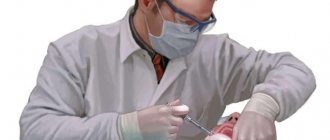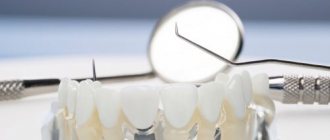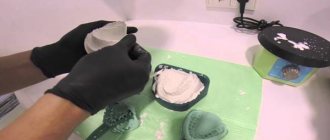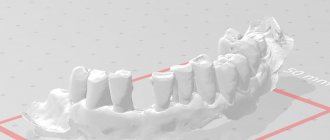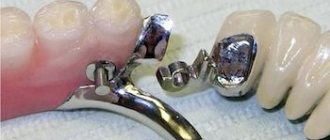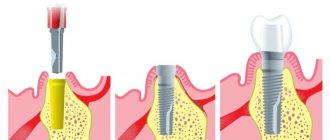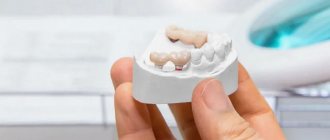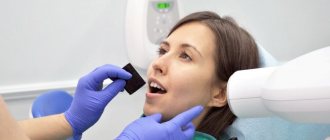Despite the fact that dental implantation is still considered something new in our country, it is widespread throughout the world and has been used for several decades. Today it is generally accepted that this is the most reliable way to replace missing teeth.
Proper planning for implantation of lost teeth
Before proceeding with the restoration of lost teeth with implants, specialists study the clinical situation: a face-to-face examination is carried out, computed tomography images and orthopantomograms are studied, photo documentation is carried out, the presence of chronic diseases in the patient, medications taken is determined...
In some cases, it may be necessary to consult doctors of other specialties (most often a cardiologist and a therapist) and even undergo some blood tests: HIV, HBS, HCV, RW. Before implantation, it is advisable to have an “office” teeth cleaning with a hygienist a week or two before implantation.
The current clinical situation is discussed with the patient and a treatment plan is outlined.
Dental implantation is a several-stage operation that extends over time, so planning is an important stage in the successful installation and healing of implants.
Classic implant installation protocol
Let's consider the case when dental implantation is carried out only on the basis of data obtained from an orthopantomogram (OPTG).
From the OPTG image we obtain the following information:
- based on the contrast of a 2-dimensional image, the presence of bone in the proposed implant installation site;
- the approximate height of the bone (the fact is that the picture is taken at an angle)
do not get complete information from the OPTG image
- about the actual distance from the bone crest to the mandibular canal or maxillary sinus;
- about the real cross-sectional profile of the bone.
Thus, using only the OPTG image, the doctor receives about 50% of the necessary information (conditionally), and the patient must rely solely on the experience and qualifications of the surgeon performing the implantation. A doctor's mistake can lead to the following:
- a complication may occur in the form of damage to the mandibular nerve, and, as a result, paresthesia (numbness of the lip and chin).
- Another error associated with the lack of information is illustrated in the following OPTG - perforation of the maxillary or nasal sinuses is shown, after such an “operation” the patient receives a referral to ENT specialists instead of teeth.
- Another type of complication is perforation of the cortical plate by drills or implants and, as a result, bone resorption. Unfortunately, what you see in the pictures is a real case.
For example, in the right figure we have modeled the correct direction of the implant axis that needed to be selected.
Cross-sectional sections show that the apical part of the implant is located in the mandibular canal and damages the nerve.
2) Now consider the case when, in preparation for implantation, the doctor has at his disposal a Computer Tomogram (CT) of the patient
Because From a CT scan it is possible to obtain all the data on bone volume in all planes and sections, then the completeness of information can be conditionally estimated at 75%. Where is the remaining 25%? Our experts believe that 25% is a prosthetic plan that was previously thought out and modeled in a 3D program. Let us remember the main purpose of installing implants – restoration of defects in the dentition. Each implant carries the function of supporting a future crown, as well as supporting a bridge for its fabric.
Incorrect installation of the support, and the structure becomes loose, loses strength, and as a result, the bridge collapses, and in the case of teeth, reimplantitis and other complications develop
Of course, an experienced orthopedist can mentally imagine exactly how 1, 2, 3 or 4 teeth will be located in the dentition, but what to do when there are more missing teeth? And if the orthopedist only has an approximate idea of what the teeth will ultimately look like, then how can the surgeon understand where he should place the implants?
Still, let’s assume that the orthopedist is experienced and, having a CT scan in hand, he made markings for implantation for the surgeon (indicated on the CT scan the exact location of the implants).
Now it's time for implantation. As a visual example, imagine a photograph of a dental model, indicating the sizes and positions of the holes that should be drilled.
The surgeon must complete the orthopedist's task, working by eye. Not that easy, right? If the holes are drilled with a deviation of only 1-2 millimeters, the treatment plan that the orthopedic surgeon has in mind will not be implemented, and the model will be thrown into the trash. In real life it is more difficult, the surgeon works in cramped conditions, his blood pressure may drop, and the patient may move involuntarily. At best, the orthopedic design will not be installed perfectly; at worst, harm to the patient’s health will be caused.
The photograph shows a case where the implants were installed in the wrong direction. How to get prosthetics now? But the conditions made it possible to install them at the desired angle.
Another clinical case: with missing teeth 45 and 46, one implant was installed because... at the time of its installation, due to bone deformation, the distance between teeth 44 and 47 was only 12.5 mm. There is a lot of space for one tooth, but not enough for two. This is a case where the surgeon performed implantation without prior orthopedic planning. In such a situation, the orthopedist can no longer change anything, so he is forced to provide prosthetics “as best he can.”
Our clinic’s specialists believe that the most important part of dental restoration using implantation is a properly developed strategy. In its absence, the probability of an error is very high, which is what happened. The exhausted patient subsequently contacted us with complaints about the unsatisfactory appearance of the teeth and inconvenience in use. It’s sad, but to correct the situation, you will need to remove the previously installed implant.
So, successful installation of implants using the standard method often depends 100% on the qualifications of the orthopedist and implant surgeon, the patient’s patience and other factors. The cost of an error can be either a “crooked” (in other words, there is no way to describe it) final design, or harm to the patient’s health.
How to avoid such complications? A new development by Russian scientists, implantation using templates, comes to our aid - the Implant-Guide technology.
Trust the beauty of your smile to professionals
Dentistry in Lyublino “Good Hands” has been operating on the Moscow market for more than 5 years and has earned a huge number of positive reviews from regular customers. We carry out:
- Comprehensive diagnostics.
- Taking impressions and creating a plaster model.
- Selection and installation of implants.
- Monitoring results and assistance in the rehabilitation process.
We use the best implants from manufacturers from Switzerland, Germany, and Israel. To make an appointment for diagnostics, call us during business hours.
3D implantation planning and navigational implantation using individual templates
To obtain the remaining 25% of data, when planning implantation, we use special radiopaque templates during CT scanning. Already at this stage, using templates, we predict future orthopedic designs. The template is somewhat reminiscent of a removable denture resting on your own teeth.
Now from the CT image we receive additional data: the shape and type of the future orthopedic structure allow us to choose the best direction for installing the implant, and information about the thickness of the mucosa in the implantation area will allow us to predict the fit of the gum to the crown. Thus, before implantation, we select the surgical protocol and the optimal implantation technique. We know exactly, and do not decide “on the spot”, what type of incision will be made (straight, beveled or WITHOUT A CUT AT ALL), what protocol we will use (one-stage or two-stage), what to prepare in advance (for example, a healing abutment or a plug). Is implantation possible with immediate loading, etc. Based on the table of implants, we will prepare in advance the necessary implants and drills for the correct operation.
This technology allows us to virtually plan and play out implantation, based on the location and type of future orthopedic structure.
At the end of the calculation, an implantological template is made, into which special titanium guide bushings are installed, according to which the doctor will accurately install the implants.
How is diagnostics carried out?
At the first stage, a computed tomography (abbreviated as CT) is performed. This is a study that allows you to obtain a three-dimensional image of the patient’s entire jaw system. Based on these data, the volume and quality of bone tissue, the position of the nerves and sinuses are assessed. The doctor will determine whether there are any pathologies of the jaw system that may become an obstacle to implantation (cysts, granulomas, foci of chronic periodontitis, etc.).
As a rule, we perform CT scans using our own diagnostic equipment.
Tomographs for dentists and specialized centers differ primarily in their resolution. Accordingly, the higher the magnetic field strength of the device, the more detailed the images will be and the more informative the research itself will be.
In most situations, the dental apparatus is more than enough: the teeth and jaw system are not kidneys or the brain, where a special configuration of sections and high resolution are required. But in difficult situations, if the doctor has to work not only with the jaw system, but also use other bones of the skull (in particular, the zygomatic bone), a more detailed and high-quality image is needed, and this can only be obtained with professional and more expensive diagnostic equipment. Therefore, in such situations, we refer the patient to a specialized diagnostic center to conduct CT and even MSCT (multispiral computed tomography).
What's the difference in price?
The difference in price is the cost of producing radiopaque and implantation templates. For assessment, for one jaw, regardless of the number of implants installed, you will need to pay an additional 26,000 rubles. to the planned cost of the implantation operation. Often, when it comes to a simple case of installing a single implant, we can do without making templates. An implantological template is used when installing 2 or more implants, then the price increase will be 13,000 per implant. If there are even more implants, the cost of the template ceases to play a significant role in the price of treatment.
How is the oral cavity prepared?
Before dental implantation, regardless of how many teeth are planned to be restored, it is necessary to prepare the entire oral cavity. It is very important to eliminate any inflammatory processes, since their development is provoked by microbes and bacteria that can get into the hole and thereby cause inflammation of the tissues around the implant. That is why the oral cavity should be as sterile as possible.
Treatment of caries, pulpitis
All inflammatory processes of periodontal tissues, dental diseases (caries, pulpitis, periodontitis) and even ordinary deposits on the enamel are nothing more than bacteria. This means that during implantation, they can get inside the wound and cause tissue inflammation. The risk of developing peri-implantitis and rejection of the structure increases. Therefore, it is very important to treat the teeth that are directly adjacent to the defect area, as well as on the opposite jaw, so that the surgical area is sterile. If a large number of teeth are destroyed, then, of course, it is advisable to cure them all.
Removing dental plaque
Cleaning before implantation is also a mandatory preparation step. As with tooth decay, plaque and tartar can cause inflammation. The cleaning is carried out deep, that is, deposits are necessarily removed from under the gums. Therefore, if there is a need, gum curettage is prescribed instead of the traditional hygiene complex.
So, what are the advantages of the ImplantGuide technology?
- Full mutual understanding between the orthopedist, surgeon, and dental technician in choosing the best design, the ability to involve other specialists before and at the stage of implantological treatment;
- Optimal placement of the implant as a support for the future orthopedic structure;
- Selection of the optimal individual operating technique in each clinical case;
- Precise positioning of the implant in the planned location;
- 2-5 times reduction in the time of dental implantation surgery;
- Minimal trauma, pain and swelling after surgery, reducing the likelihood of dental complications;
- 100% predictable and guaranteed final aesthetic result;
- Possibility of installing implants without incisions (bloodless implantation method);
- Allows you to perform precise and safe operations.
Why take tests before dental implantation?
Our patients undergo blood tests and, in some cases, urine tests before dental implantation. They allow you to assess the patient’s current health status, clarify blood clotting readings, the presence or absence of viral or bacterial infections in the acute period.
After the tests, we are unlikely to refuse you dental implantation - when planning treatment, you already fill out a questionnaire that allows us to draw conclusions about the state of your health. But the tests will allow us to understand whether implantation can be carried out right now or whether it makes sense to postpone it for a while and put chronic diseases into remission.
We especially insist on testing for women over 50 years of age: an expanded complex is provided for them, since during this period it is necessary to take into account that some body functions work slightly differently. You can read more about the specifics of implantation in women in our special article.
An expanded list of tests is also provided if the patient plans to undergo implantation under general anesthesia or sedation.

